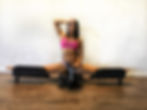How To Do The Splits - aka HELP!!
- Michelle Shimmy
- Nov 13, 2017
- 6 min read
Ahhh the splits... the ever elusive flexibility goal of dancers, yogis, aerialists, gymnasts and party-goers-with-no-party-trick worldwide!! Whenever you see someone casually drop into a split, it looks so easy - but if you've ever tried it yourself, you'll know immediately that it's not as straightforward as it seems...
It looks painful! Why would I even want to try?

The benefits of flexibility training are numerous. Having greater mobility and range of movement helps with a surprising number of sports and activities, from the obvious ones like yoga, dance, gymnastics and cheerleading, to the less obvious ones like football, martial arts, rock climbing and calisthenics.
Being more flexible can help to prevent injuries, increase performance, and help with your posture. Stretching reduces stress and releases endorphins.
And let's not forget one of the most important benefits - being more flexible feels AMAZING! It's a wonderful feeling to use your body to its full potential, without feeling restricted or stiff.
I have no idea where to start! Where do I begin?
Simple - you begin at the beginning! It really doesn't matter how inflexible you are to start with. Think of it this way - the less flexible you are to start with, the greater your potential for incredible progress! Don’t be disheartened - get excited. Don’t put off getting started.
Trust me, a year from now you will wish you had started today. Click on the images below to read about these ladies and their splits stories!

Sarah: "I'm so excited to finally share my splits progress with the help of Michelle Shimmy's tutorials. I've always felt my progress wasn't going any far but with the help of the tutorials, I had the motivation, determination and consistency."
Tips for getting started
1. Enrol in flexibility classes.
I don’t just mean buy a casual class. COMMIT TO YOUR GOALS. Buy a full course or a term of classes and go to all of them. If you miss one, do a catch up class (make sure you enrol in a studio that allows you to catch up classes - like my studio, the Pole Dance Academy).
I cannot stress how crucial the commitment is. It might seem like a great option to have the flexibility of casual classes (no pun intended!), but unless you commit to regular flexibility training, you won’t get your best results.
Face-to-face flexibility training in a class environment with a good instructor is the best way to start. Your instructor should give you stretches to suit your level, and make corrections to your form if necessary.
Make sure the classes incorporate strengthening exercises, because it's important to build strength and flexibility together. Active flexibility training is very important! Check out our timetable here.
2. Make stretching at home a part of your weekly routine.
Face-to-face classes are great, and having access to a knowledgeable instructor is the best way to train. However, sometimes money, time and distance can impact your ability to take more than one class a week. You can complement your training by stretching at home using a flexibility tutorial.
I have a splits tutorial you can try - Splits With Shimmy. You can download any of our tutorials here, including Maddie Sparkle’s Middle Splits Tutorial. As a special offer to our Pole Dance Academy Blog readers, use the discount code BLOGSALE20 to get a big discount - reduced from $35 to only $20 AUD! Go to www.shimmyandsparkle.com
3. Warm up!
It's essential to make sure your muscles are really warm before you stretch them. Personally, I do a 15-20 minute warm up before I begin to stretch deeply. Do not stretch without doing a thorough warm up first. Your warm up should get your blood flowing and your heart pumping.
A normal stretch session for me lasts about an hour, sometimes more. Generally, 30 - 60 minutes per stretching session is a good way to start.
4. Stretch regularly and consistently.
I recommend stretching 3 times a week for the best results, with rest days in between where you only do some light stretching. If you only stretch once a week, you will still see improvements, but you will get better results with 3 sessions a week. As you improve, you will be able to increase the number of stretch sessions per week.
Remember: flexibility is a long term goal. You cannot rush it, or you will risk injuring yourself. Being flexible is a lifestyle. You need to maintain it. It is not a goal that you can achieve without a long term commitment. It might sound crazy now, but after a while you actually start to enjoy stretching! I love a good stretch session. It feels amazing to me now, but I can definitely remember how hard it was when I first started.
Pro tip: try making stretching fun! Stretch at the beach or at a park with a friend.
5. Learn the difference between good stretching, and “bad” pain
Stretching for greater flexibility is definitely hard work! And yes, it can feel uncomfortable - this is perfectly normal. However, don’t push yourself too far! DO NOT stretch to the point of injuring yourself! Listen to your body. "Bad pain" is not ok.
Generally speaking, sharp pain, pinching, crunching, sharp joint pain or intense localised pain is BAD PAIN. You shouldn't experience nerve symptoms (pain that extends across multiple muscle groups or zinging, tingling, pins and needles, numbness etc).
Good stretching shouldn't actually feel like pain at all, it should feel like resistance. Discomfort is normal, but it should not be sharp, and should increase steadily as the stretch intensifies. You should feel as though holding the stretch helps you to improve and relax into the pose while you are in the stretch, and it should not feel as though the muscles are tightening or your flexibility is worsening as you hold or repeat the pose.
Stretch to the point of discomfort but not pain. The more you stretch, the more you will get to know your body and your limits. So start gently and increase the pace when you feel ready.
As my physio Maria Anagnostou says:
"Not all bodies are structurally shaped or put together the same way. Stretching often needs to be modified or adjusted for the individual. If a particular stretch feels "wrong", having an assessment by a physiotherapist to better understand why and how to make safe flexibility gains can be really valuable and helpful."
If you're in Sydney and interested in getting a flexibility assessment done, you can contact Maria. She'll be happy to help you out!
6. Use your breathing to assist you in your stretching
If you've ever taken a yoga class, you'll know how much emphasis yogis place on correct breathing techniques during yoga. And they're completely right!
When you stretch past your body's usual range of motion, it feels uncomfortable. If you go too far, you will experience pain. This is your body sending you warning signals that what you are doing is outside what your body considers to be a normal and acceptable range of motion, and your body is trying to tell you that you might be in danger. Part of flexibility training is reprogramming your body and your brain to accept a bigger range of motion as "normal," and therefore safe.
This is why it is so important to remain relaxed and calm while you stretch. You are trying to teach your body and brain that what you are doing isn't dangerous. It's also another reason why you need to go slow and steady. It's no good trying to convince your body to accept your attempts at increasing your range of motion if you end up over-stretching and hurting yourself!
Your muscles will automatically tighten when you begin to stretch them. When you hold the stretch, they will start to relax after about 20-30 seconds. You can use your breath to help this process, especially when holding static stretches.
If you hold your breath, or breathe shallowly and rapidly, it prevents your muscles from relaxing, and restricts the flow of oxygen and blood to your muscles.
So try to breathe deeply and evenly while you stretch. I try to imagine that I'm breathing into the muscle(s) being stretched, and when I exhale, I relax deeper into the stretch. Breathing deeply helps your muscles to relax, and it helps you to relax too.
7. Enjoy the process!
You're about to embark on a journey of self-discovery, learning all the things your body can do that you never dreamed possible! Enjoy it. Don't get disheartened if you feel like you're not making progress (or even getting worse). Your flexibility changes according to many factors - how hydrated you are (drink lots of water!), how tired you are, how much exercise you've been doing, how stressed you are, and for women - even where you're at in your cycle.
Stay motivated by taking lots of photos at the end of your stretching session so you can track your progress. There is literally nothing more motivating than seeing your own progress over time! I love finding old photos - it really makes me happy to see my flexibility improve over the years. Take a look at the photo collage below to see Maddie Sparkle and my progress over the years - next to Amber Ray and her beautiful standing split!
Remember, head to www.shimmyandsparkle.com and use the discount code KICKSTART2018 to get a big discount off all tutorials - reduced from $35 to only $20 AUD!
If you have any questions, please comment below and I will do my best to help!
Happy stretching :-)
Shimmy xxx















